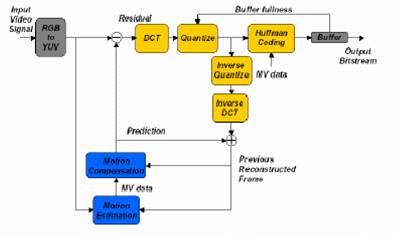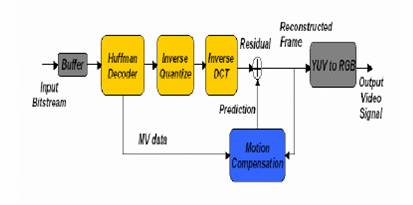CSE/EE 485: Digital Image Processing IComputer Project Report # : Project 5Image Compression and Mathematical MorphologyGroup #4: Isaac Gerg, Pushkar DurveDate: December 5, 2003 |
||||||||||||||||||||
|
|
||||||||||||||||||||
| A. |
Objectives
|
|||||||||||||||||||
| B. |
Methods There is one 'M' file for this project. project5.m contains four parts.
1. JPEG compression analysis Executing project5.m from Matlab At the command prompt enter:
|
|||||||||||||||||||
| C. |
Results Results described in order following Methods section above. Part 1
We then created a loop from 1 to 10 and ran the compression algorithm described above on the original image. With each iteration, we multiplicatively scaled the quantization matrix by the loop index to see its effects on compression. You can see that as the iteration get higher, the compression ration increases and image quality is lost. The factor used to adjust the quantization matrix is called the Q-Factor.
Below is a plot of the compression ration versus iteration.
JPEG Encoder Block Diagram
JPEG Decoder Block Diagram
The DCT-based encoder can be thought of as essentially compression of a stream of 8x8 blocks of image samples. Each 8x8 block makes its way through each processing step, and yields output in compressed form into the data stream. Because adjacent image pixels are highly correlated, the `forward' DCT (FDCT) processing step lays the foundation for achieving data compression by concentrating most of the signal in the lower spatial frequencies. For a typical 8x8 sample block from a typical source image, most of the spatial frequencies have zero or near-zero amplitude and need not be encoded. In principle, the DCT introduces no loss to the source image samples; it merely transforms them to a domain in which they can be more efficiently encoded. After output from the FDCT, each of the 64 DCT coefficients is uniformly quantized in conjunction with a carefully designed 64-element Quantization Table. At the decoder, the quantized values are multiplied by the corresponding QT elements to recover the original unquantized values. After quantization, all of the quantized coefficients are ordered into the "zig-zag" sequence. This ordering helps to facilitate entropy encoding by placing low-frequency non-zero coefficients before high-frequency coefficients. The DC coefficient, which contains a significant fraction of the total image energy, is differentially encoded. Part 2
Part 3
MPEG Encoder Block Diagram
On the left side the original image can be
seen, which is represented by its luminance signal and its two chrominance
signal components. A motion compensated image is then subtracted from the
original image. In the case that the original image is a B- or P-picture, the
motion compensated image is an estimation of the original image. In the case,
that the original image is an I-Picture, one can assume a motion compensated
image with all pixel values being equal to zero. The motion compensated image
comes from the motion compensation box. MPEG Decode Block Diagram
The MPEG decoder reads the data out of sequence, does the frame recomposition taking into account the stored motion information and differential frames present, and then reorders the frames into correct time sequence before outputting them. Part 4 This part used the image segmentation algorithm and did a good on the non-rotated and 90 degrees images. This can be seen in Figure 8 and Figure 9. The algorithm did not perform too good on 45 degree rotated source as seen in Figure 10. The reason the Algorithm 3 of Part 10 did not work was because a command was done to fill all holes in the object. Edge detection detected the bouding in the 45 deg. rotated image and bounded it, thus killing the object.
CPU Time: 23.0930 secs |
|||||||||||||||||||
| D. |
Conclusions Uncompressed multimedia (graphics) data requires considerable storage capacity and transmission bandwidth. Despite rapid progress in mass-storage density, processor speeds, and digital communication system performance, demand for data storage capacity and data-transmission bandwidth continues to outstrip the capabilities of available technologies. The recent growth of data intensive multimedia-based web applications have not only sustained the need for more efficient ways to encode signals and images but have made compression of such signals central to storage and communication technology. A common characteristic of most images is that the neighboring pixels are correlated and therefore contain redundant information. The foremost task then is to find less correlated representation of the image. Two fundamental components of compression are redundancy and irrelevancy reduction. Redundancy reduction aims at removing duplication from the signal source (image/video). In general, three types of redundancy can be identified:
Image compression aims at reducing the number of bits needed to represent an image by removing the spatial and spectral redundancies as much as possible. Mathematical Morphology is the analysis of signals in terms of shape. This simply means that morphology works by changing the shape of objects contained within the signal. There are many more applications that morphology can be applied to. Morphology has been widely researched for use in image and video processing. |
|||||||||||||||||||
| E. |
Appendix project5.m source code. |
|||||||||||||||||||
|
|
||||||||||||||||||||




















